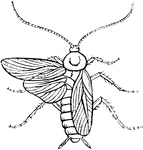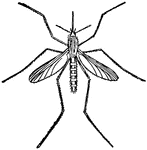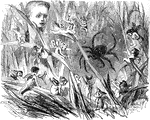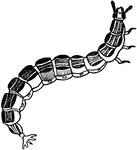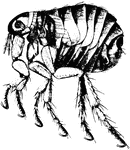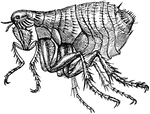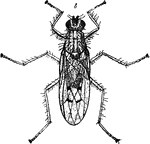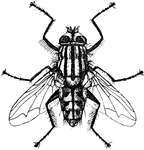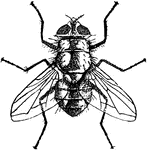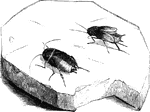
Common Cockroach
"Blattina includes the Cockroaches, the most noted species of which, the Black beetle or Common…
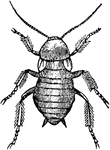
Female Cockroach
"A genus of Orthopterous insects, having an oval or orbicular flattened body, the head hidden beneath…

Female Cockroach
Cockroaches belong to the order Orthoptera. Cockroaches are harmful to plants in every stage after leaving…

Male Cockroach
"A genus of Orthopterous insects, having an oval or orbicular flattened body, the head hidden beneath…

Cocktails
"The larvae are very similar to the perfect insects, both in appearance and habits. Many of them feed…

Larva of the Colorado Beetle
The larva of the colorado beetle is very unlike the adult insect. The larva is harmful to gardens.

Common Ground Beetle
The common ground beetle feeds mostly on insects, though some of them are partly vegetarian.

Cricket
Crickets, family Gryllidae (also known as "true crickets"), are insects somewhat related to grasshoppers…
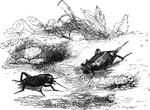
Field Cricket
"Another species of cricket is the Field-cricket, a timid animal which avoids the society of man, living…

Field Cricket
The Field Cricket (Gryllus pennsylvanicus) is an insect in the Gryllidae family of crickets. It was…
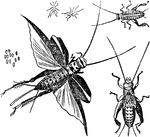
House Cricket
"House Cricket (Gryllus domesticus): a, eggs; b, young just hatched; c, full-grown larva; d, pupa; e,…

House Cricket
House crickets are in the order Orthoptera. Crickets are destructive to plants in every stage after…
!["Like that animal [the mole] it is constantly engaged in burrowing in the earth; and to enable it to do this with facility iits anterior limbs are converted into a pair of flat, fossorial organs, which are turned outward in exactly the same manner as the hand of the mole. In its pasage through the earth it does great injury to the roots of plants, but it said to live quite as much upon animal as vegetable food." — Goodrich, 1859](https://etc.usf.edu/clipart/14900/14935/molecricket_14935_mth.gif)
Mole Cricket
"Like that animal [the mole] it is constantly engaged in burrowing in the earth; and to enable it to…

Mole Cricket
The mole cricket (Gryllotalpa vulgaris) is an insect named for their highly developed forelimbs and…

Rose Curculio
"Rose-curculio (Rhynchites bicolor). a, beetle; c, same in profile; b, claw." -Whitney, 1911
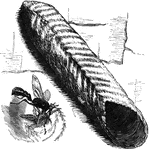
Dauber
"A South American genus, Pelopaeus, allied to the preceeding, is called the Dauber, from its…

Devil's Coach Horse
The Devil's Coach Horse is also known as Rove Beetles. These beetles feed largely on decaying matter.
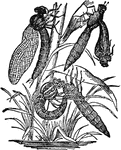
Dragonfly
"The Dragon Fly has a large, broad head, very freely attached to the thorax, and large, convex, prominent…
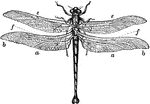
Dragonfly
An insect characterized by large multifaceted eyes, two pairs of strong transparent wings, and an elongated…

American Dragonfly
"They are often seen moving with a rapid flight over rivers, ponds, and meadows, alighting for a moment,…

Eleanor Dragonfly
"Among the larger kinds of dragon-fly is the Libellula depressa of Linnaeus, common in Europe,…
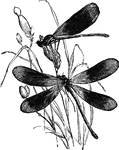
Virgin Dragonfly
"One of the most beautiful species of Euopean dragonflies is the Virgin Dragon-fly, Libellela virgo,…
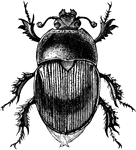
Drone Beetle
"Drone-beetle (Geotrypes splendidus). GEOTRYPES. A Fabrician genus of beetles typical of the family…

Earwig
Spongophora brunneipennis is a species of earwig, and insect distinguished by forceps on its abdomen.
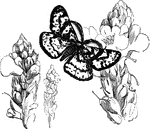
Fidonia Plumistaria
"The European Fidonia Plumistaria, is distinguised by its curious feathery antennae." —…

Fig Insect
"The fig insect will not lay eggs in the Smyrna fig, but only in the wild fig; therefore one individual…

Fire-fly
Illustration of a fire-fly commonly found in the West Indies. Its scientific name is Pyrophorus noctilucus.
Flat-Headed Borer
Flat-Headed Borer is the common name of Chalcophora virginiensis. The insect extendsd its flattened…

Flea
"Aphaniptera includes the fleas, which, despite their minuteness, have made themselves a name in the…
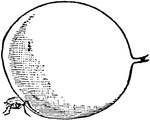
Chigoe Flea (Female)
The chigoe flea (Tunga penetrans) is a parasitic arthropod found in tropical climates, especially South…
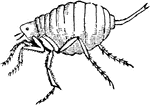
Chigoe Flea (Male)
The chigoe flea (Tunga penetrans) is a parasitic arthropod found in tropical climates, especially South…

Human Flea
The human flea (Pulex irritans) is a parasitic insect that actually has several hosts despite its name.
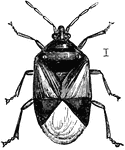
Insidious Flower Bug
The Insidious Flower Bug is an insect in the Heteroptera suborder of true bugs.
Robber Fly Larva
The larva of Efferia aestuans (or Erax bastardi), an insect in the Asilidae family of robber flies.

Robber Fly Pupa
The pupa of Efferia aestuans (or Erax bastardi), an insect in the Asilidae family of robber flies.

Boat Fly
"They carry the air required for their respiration in a space left for this purpose between the wings…

Mature Botfly
"After attaching themselves to the walls of the stomach, the botfly larva are nourished by the blood…
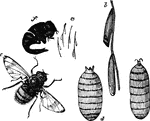
Breeze Fly
"a, eggs of the Breeze-fly; b, the same magnified; c, larva, or bot; d, chrysalis; e, perfect insect;…
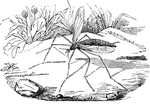
Crane Fly
"The tipulidae have the proboscis short, terminated by a pair of fleshy lips, inclosing two bristles."…
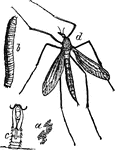
Crane Fly
"Crane-fly (Tipula oleracea): a, eggs; b, larva; c, pupa case as left by the insect, sticking out of…
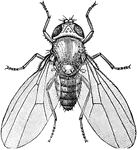
Common Fruit Fly
The Common Fruit Fly (Drosophila melanogaster) is an insect in the Drosophilidae family. The species…

Hessian Fly
The hessian fly or barley midge, Mayetiola destructor, is a species of fly that is a significant pest…

